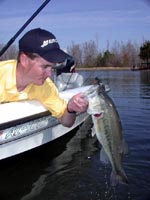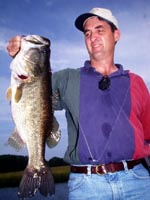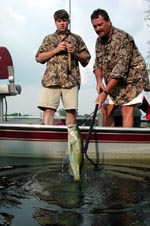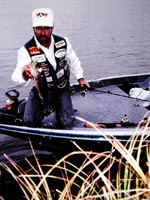
|
Features
|
|
|
|
Books
|
|
|
|
Fun & Games
|
|
|
|
Contact Us
|
|
|
John's Journal... Entry 197, Day 5
KEN COOK ON BASS FISHING
Ken Cook's Doodling Worm Technique
 EDITOR'S
NOTE: Ken Cook of Meers, Oklahoma, a professional
bass fisherman since 1983, and before that a fisheries biologist, won
the BASS Masters Classic in 1991, as well as other B.A.S.S. events.
EDITOR'S
NOTE: Ken Cook of Meers, Oklahoma, a professional
bass fisherman since 1983, and before that a fisheries biologist, won
the BASS Masters Classic in 1991, as well as other B.A.S.S. events.
Question: Ken, what is doodling?
Answer: Well, fishing for bass has gotten tough. Anglers are having a
rough time catching fish on crankbaits, spinner baits and/or jerkbaits.
Therefore, many fishermen have started slowing down and fishing deep,
clear water. And I don't know of any better technique for fishing deep,
clear water than doodling a plastic worm.
Most anglers who doodle use a plain, straight-tail worm. I'll usually Texas-rig a straight-tail worm with a 1/4-ounce to a 1/16-ounce sinker, depending on how deep I'm fishing. If I'm fishing a bigger worm, I'll fish with a 1/8- or a 3/16-ounce sinker. I use a glass bead and Berkley's Vanish, a fluorocarbon line that's truly revolutionizing worm fishing. Vanish sinks with the bait because it's heavier than nylon line and has less stretch and more hook-setting strength. So you have two advantages. One, you feel more confident because the line goes straight to the bait and doesn't have the coil in it that nylon does since nylon floats, and Vanish also falls faster, getting the bait to the bottom quicker. Often I'll use 6-pound-test line, sometimes 8-pound-test up to 10-pound-test line with this technique because I'm fishing 10 to 40 feet deep, often vertically.
 For
instance, when you read the fish on your depthfinder, and you'll be able
to tell whether the fish are suspended up off the cover or holding on
the bottom. The doodling technique involves shaking the rod tip. I use
a rattling brass sinker, a Thunder Bull, which already has rattles in
the sinker. Then I'll put on a glass bead and tie it to the hook. When
I shake the rod tip, it all rattles together. Watch it in the water when
you drop your rod tip. The sinker, the bead and the worm will separate.
When you jerk it, it all comes back together and that makes it click.
As you shake the rod tip, you're clicking the sinker and the glass bead
together, which gives off a lot of noise and attracts fish to the bait.
Many times you'll pull fish a long way with this technique, even in clear
water. What you're doing is creating an attraction through sound. You
have a little finesse worm that looks like something easy for the fish
to eat. This technique really pays off in bass when you fish deep, clear
water when the fish aren't biting.
For
instance, when you read the fish on your depthfinder, and you'll be able
to tell whether the fish are suspended up off the cover or holding on
the bottom. The doodling technique involves shaking the rod tip. I use
a rattling brass sinker, a Thunder Bull, which already has rattles in
the sinker. Then I'll put on a glass bead and tie it to the hook. When
I shake the rod tip, it all rattles together. Watch it in the water when
you drop your rod tip. The sinker, the bead and the worm will separate.
When you jerk it, it all comes back together and that makes it click.
As you shake the rod tip, you're clicking the sinker and the glass bead
together, which gives off a lot of noise and attracts fish to the bait.
Many times you'll pull fish a long way with this technique, even in clear
water. What you're doing is creating an attraction through sound. You
have a little finesse worm that looks like something easy for the fish
to eat. This technique really pays off in bass when you fish deep, clear
water when the fish aren't biting.
 Question:
Is doodling usually a hot-weather technique?
Question:
Is doodling usually a hot-weather technique?
Answer: Generally doodling is a summertime technique, but it works very
well in cold weather, too. I use the same tactic with maybe a jig head
or a little more bulky bait in the wintertime. This jig head will slow
down the fall of the bait, and you'll get a little more action with a
curly-tail grub. But in the summertime, I usually use the straight-tail
Power Finesse Worm.
Question: You've got a finesse rod, right?
Answer: The Ken Cook Signature Lightning Rod we've designed for this is
a 6-foot, 4-inch medium-heavy fast-action rod with a stout butt. But the
tip is light enough that you can cast light bait with it. You have sensitivity
because of the light tip, and yet you have enough butt power to set the
hook. When you Texas rig a worm to doodle, you'll have the hook buried
in the plastic. You need power in the rod to set the hook, even with 6-
or 8-pound test line. This rod has the right amount of power and yet it
has a tip that allows you to feel the bait and make casts with light bait.
 Question:
What makes your finesse rod different from everybody else's?
Question:
What makes your finesse rod different from everybody else's?
Answer: This rod has super-hard stainless-steel guides that give it tremendous
balance. I'll put an Abu Garcia reel on it, depending on the size of line
I'm using. With those reels, the rod balances perfectly. It's not tip-heavy
because the stainless-steel guides are very light and make your rod tip
very lightweight, which contributes a great deal to sensitivity. The rod
is well-balanced and has the right action. This rod has everything you
need for doodling a worm.
Check back each day this week for more about KEN COOK ON BASS FISHING ...
Day 1 - Swimming-Worm Technique
Day 2 - Ken Cook's Spinner Bait Tactic
Day 3 - Ken Cook's Jerkbait Method
Day 4 - Ken Cook's Crankbait Strategy
Day 5 - Ken Cook's Doodling Worm Technique